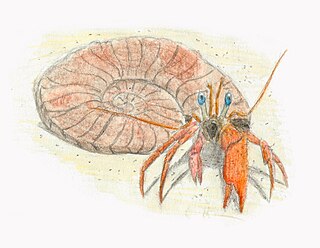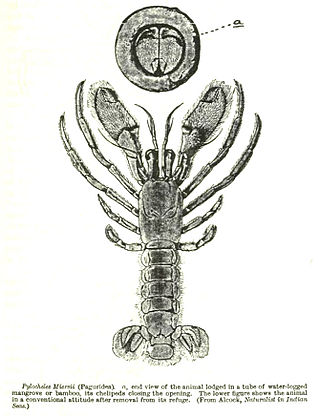
Hermit crabs are anomuran decapod crustaceans of the superfamily Paguroidea that have adapted to occupy empty scavenged mollusc shells to protect their fragile exoskeletons. There are over 800 species of hermit crab, most of which possess an asymmetric abdomen concealed by a snug-fitting shell. Hermit crabs' soft (non-calcified) abdominal exoskeleton means they must occupy shelter produced by other organisms or risk being defenseless.

Porcelain crabs are decapod crustaceans in the widespread family Porcellanidae, which superficially resemble true crabs. They have flattened bodies as an adaptation for living in rock crevices. They are delicate, readily losing limbs when attacked, and use their large claws for maintaining territories. They first appeared in the Tithonian age of the Late Jurassic epoch, 145–152 million years ago.

The Diogenidae are a family of hermit crabs, sometimes known as "left-handed hermit crabs" because in contrast to most other hermit crabs, its left chela (claw) is enlarged instead of the right. It comprises 429 extant species, and a further 46 extinct species, making it the second-largest family of marine hermit crabs, after the Paguridae.
Etyiidae is a prehistoric family of dromiacean crabs only known from Cretaceous and a few Paleocene fossils.

Palaeopagurus is an extinct genus of hermit crab from the Lower Cretaceous.

The Pylochelidae are a family of hermit crabs. Its members are commonly called the 'symmetrical hermit crabs'. They live in all the world's oceans, except the Arctic and the Antarctic, at depths of 2,000 m (6,600 ft). Due to their cryptic nature and relative scarcity, only around 60 specimens had been collected before 1987, when a monograph was published detailing a further 400.

Eryonidae is a family of fossil decapod crustaceans which lived from the Upper Triassic to the Lower Cretaceous. It contains four genera: An aggregation of three unidentified eryonids was reported in 2012 inside a Late Jurassic ammonoid of the species Harpoceras falciferum; they represent the earliest evidence of gregarious behaviour in decapods.
Ciliopagurus obesus is a fossil species of hermit crab, described from Rupelian (Oligocene) sediments at Sint-Niklaas, Belgium.

Cyclida is an extinct order of crab-like fossil arthropods that lived from the Carboniferous to the Jurassic and possibly Cretaceous. Their classification is uncertain, but they are generally interpreted as crustaceans, likely belonging to the superclass Multicrustacea.
Jurellana tithonia, the only species in the genus Jurellana, is a fossil crab. It was found in limestone rocks from the Ernstbrunn Formation in Austria, which have been dated to the Tithonian. It was originally thought to be the world's oldest porcelain crab, but was later determined to actually be a true crab.
Mesoparapylocheles is an extinct hermit crab genus which existed during the Mesozoic in what is now Europe. It was described by René H.B. Fraaije, Adiël A. Klompmaker and Pedro Artal in 2012. The type species is Mesoparapylocheles michaeljacksoni from the Albian or Cenomanian of Spain; which was named after the singer Michael Jackson. Genus also includes other species from the Late Jurassic (Kimmeridgian) of Germany and from the Late Jurassic (Tithonian) of Austria.
Cretatrizocheles olazagutiensis is an extinct hermit crab which existed during the Albian or Cenomanian of what is now Spain. It was described by René H.B. Fraaije, Adiël A. Klompmaker and Pedro Artal in 2012, and is the only species in the genus Cretatrizocheles.
This list of fossil arthropods described in 2015 is a list of new taxa of trilobites, fossil insects, crustaceans, arachnids and other fossil arthropods of every kind that have been described during the year 2015. The list only includes taxa at the level of genus or species.

Calappilia is an extinct genus of box crabs belonging to the family Calappidae. The type species of the genus is Calappilia verrucosa.

Necrocarcinidae is an extinct family of Late Jurassic and Cretaceous crabs. It comprises 40 species grouped in seven genera.
Pavlovskoye is a rural locality in Nebylovskoye Rural Settlement, Yuryev-Polsky District, Vladimir Oblast, Russia. The population was 9 as of 2010. There are 5 streets.
2020 in arthropod paleontology is a list of new arthropod fossil taxa, including arachnids, crustaceans, insects, trilobites, and other arthropods that were announced or described, as well as other significant arthropod paleontological discoveries and events which occurred in 2020.
Paracapsulapagurus is an extinct monotypic genus of pagurid hermit crab from the Middle to Upper Maastrichtian in what is now Senegal.

Xylopaguridae are a family of hermit crabs of the order Decapoda. It was erected in 2016 to accommodate one new genus, Prexylopagurus, and three existing genera that had previously been placed in Paguridae. They occur in the Atlantic, Indian, and Pacific Oceans.










